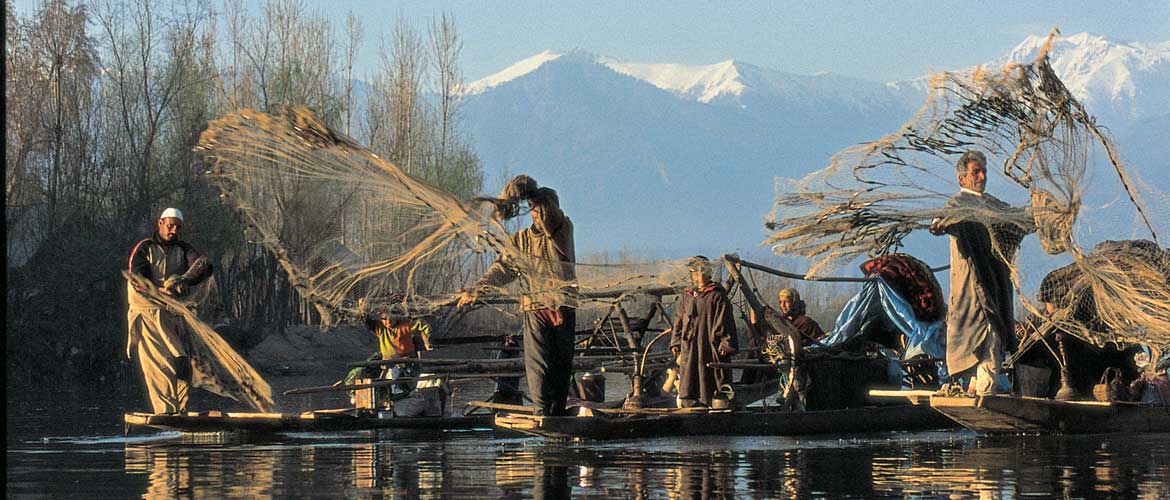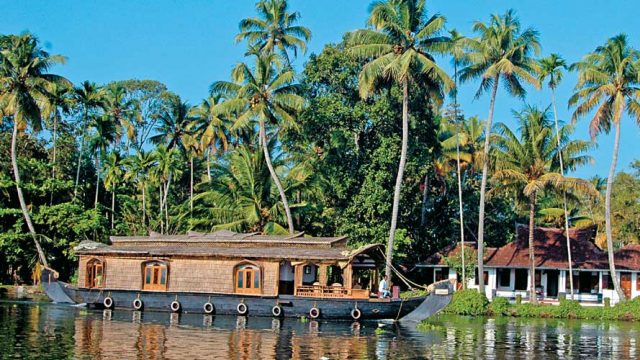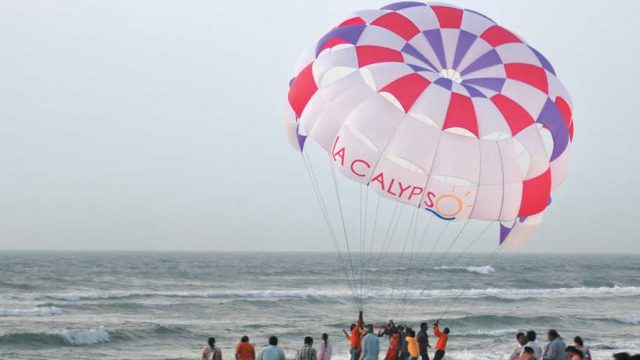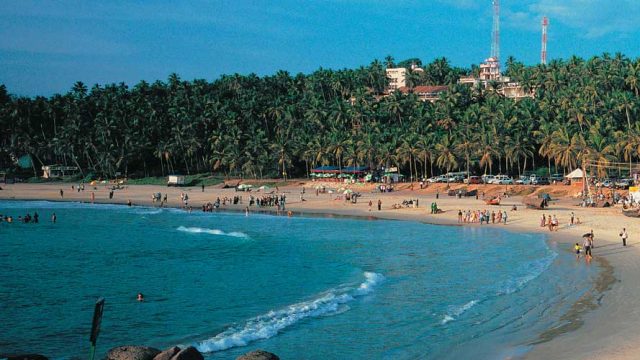In Kashmir you have to read between the lines, because there are lines everywhere.
The Jhelum, or the Veth as it is known in Kashmir, is navigable from Khanabal, 55 km upstream of Srinagar, all the way up to Baramulla, a total distance of about 110 km. The depth of the river rarely exceeds 13 feet during the dry season. However, with the coming of the rains in February, a season known locally as gand bahar, and the melting of snow in the upper reaches, the river often floods its banks. A wide network of canals and locks were designed to contain the river. These waterways connect the major lakes of the Valley to the river, and to each other. The Jhelum had eased the way of the merchant and the colonial adventurer to the plains of the Sind and allowed the occasional Mughal to spend summers drifting through the poetic charms of his dominion.

In the last decade of the 15th century, the Emperor Jehangir and his favourite queen Noor Jehan travelled the course of the river in a flotilla of royal dungas (small houseboats); Bernier accompanied Aurangzeb on a similar voyage in the 17th century and in 1840 the irascible German, Baron Charles Hügel, traversed the same course, leaving a quaint and characteristically Teutonic account of ‘shifty’ Mohammedans, wretched villages and pleasure gardens. It is, however, a path which has fallen from grace, and a journey seldom undertaken today. It is also the cause of my excitement as we glide over the reflected snows which shimmer in the turquoise-grey waters of the Dal Lake.
Under the sway of a shikara
The shikara, which was to be our home for the next five days, settled alarmingly into the waters as we piled ourselves and our unbecoming load of pots, pans, camera, sleeping bags and tents into it. After a brief tour of the Dal we headed towards Dal Gate, beyond which flows the Jhelum. By the time we got to the river, the dungas moored on the banks were buzzing with activity. The wide bay windows of each of the three rooms of these squat amphibious wooden houses were little montages of activity — girls cooked in tiny kitchens perched on the prow, while women mended fishing nets on the open front deck, and men bobbed up and down in shikaras parked alongside. We’d been on the river about an hour, and the hypnotic sway of the shikara, the rhythmic paddle of the oars, the gentle bubbling of Ibrahim’s hukkah and the rising sun had lulled me into a wafting daydream. On cue, one of our boatmen (who also doubled up as the cook) produced a glass of kahwa and some Kashmiri almond biscuits. The warm heady spice of the kahwa gave me enough energy to try my hand at rowing. After a few unbalanced steps which rocked our little shikara quite dangerously, I managed to wedge myself on the stern, a place which I was to occupy for most of the next three days, and made a few hesitant and wobbly sweeps with the oar.

“The Hanjis, or the boating community, came here in the 1400s with Timurlane from Samarkand,” explained Ibrahim, our guide, as we sailed past the Amira Kadal, the first of six cantilever bridges which span the river in downtown Srinagar. Old deodar houses with balconies leant rakishly over the river. Ghats tapered into alleyways which then disappeared into crowded neighbourhoods. Beyond the third bridge the river opens out, and the houses seem further apart. The spire of the Khanqah of Shah Hamadani comes into view.
The Kashmir countryside
Five bridges down, the wooden houses and concrete thickets of Srinagar gave way to willow and chinar trees, and small villages from which melancholy azaans blared in pious competition. Pied kingfishers hung over the river, and plummeted in little whirlwinds of feathers to pluck fish from the waters. The fishermen were bringing in their catch and we couldn’t resist buying some churu (carp) and trout for dinner. The former, being more common, was dubbed a Punjabi machhi and the latter as Kashmiri — a historical cock-a-snook at Dogra rule, and a distinction which reappeared in everything from willow to water chestnuts. At about 6 pm the sun, which had trailed us the entire day, disappeared in a haze of blue and gold, and a chill descended on the river. We decided to stop the night at a riverine isle of poplar trees opposite Dudhpokhri village. As our fish whistled and spat on the little stove, we settled down to our whisky, the snows of Yusmarg and Gulmarg shimmering tantalisingly in the light of the full moon, while snatches of conversation, and fish fry and the smoothness of my malt flowed gently into happy repose.
The morning was chilly but bright, ushered in with hot tea and a crowd of at least 50 people, sitting on their haunches, staring at us from the opposite bank. We set sail almost immediately, and arrived at the confluence of the Jhelum and the Sind at Shadipora some seven hours later. At Shadipora we wandered through Narain Bagh village. The mustard fields were in full bloom, little showers of pink were appearing on the almond and apricot trees, apple trees were being planted and wisps of smoke rose from houses which looked like Swiss chalets with their sloping roofs and open attics.

At a local government centre, a group of girls sat at their looms weaving the most intricate of silk-pashmina shawls. They laughed nervously as we peered, and questioned, but posed for us nevertheless. The rhythmic tapping of a carpet loom had us traipsing into another house, where three men were engaged in making a silk carpet. After a quick cup of tea and some garbled enquiries we paddled to Manasbal, a small but extremely beautiful lake which lies off Sumbal.
The approach to Wular
You know you’re getting close to Wular when boats piled high with water chestnuts labour by on their way to villages where women pound the pungent fruit into atta, which makes delicious naan. The pastures of Mughdamir, which stretch along the banks of the lake for miles, are dotted with gnarled water willows. Flocks of sheep and cows graze under the snows of the Harmukh range, while herds of horses left here by the villagers gallop across the network of canals which criss-cross the pastures. A few men from Qunus were trying to lasso their horses, driving them into streams in startling wild west fashion, as a bewildered group of women looked on. We shared their lunch of saag and rice before moving on.
It was getting dark by the time we arrived at Prang Ladipura, a few miles short of the lake. As I wandered through the village in the fading light, a crowd of curious kids followed me around. We stopped for the night at the home of Ahmad Aziz, and stayed up late listening to his reminisences of times past under the lonely light of a petromax lantern. He talked about his days of shikar, and sang me a song composed by Fakir Rahim Sor, in memory of a time when the rabab sang late into the cool air of a summer night.

The river flowed a little faster, and the peaks of the Harmukh range seemed closer than ever before as we wound our way through the channel that would take us to Watlab. “Look there, a shikari,” exclaimed Ibrahim, as a low-slung shikara swept past us like a scimitar. I found myself looking at an eight-foot-long matchlock which lay camouflaged across the length of the little boat poking out through the stern — a single blast from which was enough to bring down a few birds at a distance of fifty yards. The shikari pulled out a khurk (common pochard), a kus (common teal) and a shoveller he had bagged. I was to meet more shikaris on the Wular. Flocks of decoy ducks floated on the lake, stalked by the gunboats of the Wular, which from a distance looked like the bushes that litter its marshy shores.
The Wular is a vast sheet of water; winds sweep down the surrounding mountains, turning the lake into a choppy sea, whose perils are legendary. Hundreds of shikaras moved in symphonic harmony, fishing and gathering water chestnuts on the lake. Bandipora, Lakh and dozens of small towns lie scattered along the northern banks. The western banks are dominated by marshy forests which stretch all the way to Ningal in the extreme south. The late afternoon light spread in gentle arcs as I set out on an excursion from Zurmaiz village (near Watlab) for Sopore, in a fisherboy’s shikara. The wind picked up, and soon all I could hear was a gentle paddling, and the sound of my own breathing.
Later that evening, back in Zurmaiz, I listened to villagers singing dissonant ballads to the accompaniment of the rabab, sarangi, tumbakhnari (a funnel-shaped drum) and the knat (a clay pot), while a man did the bacha-nagma (a swaying staccato dance in the garb of a woman). “It’s been two years since we last sang together,” they said, thanking us for a privilege which was ours. On the opposite shore, lights were coming on in villages and army camps. The skies were crystal clear. Shadows thrown by our bonfire played on the dark waters of the lake. It had been four long days of living, sleeping and sailing on a shikara. I hadn’t had a bath, every limb in my body ached from the rowing and my legs felt wobbly on dry land. I had seen enough guns to start a war, eaten five different and equally delicious types of mutton and sailed the forgotten waters of the Vale of Kashmir. I hadn’t found a line, but I’d drifted on a beautiful nostalgic song.
THE INFORMATION
Operator Yaseen Tuman of Mascot Travels (Mobile: 09419005714) in Srinagar can put together a 5N/6D safari along the Jhelum River from Dal Lake to Wular Lake for ₹25,500 per person, for two people travelling together
Where to stay A night on a Srinagar houseboat is just the right prelude to a river safari.
Jammu Kashmir & Ladakh Guide
India
Kashmir





